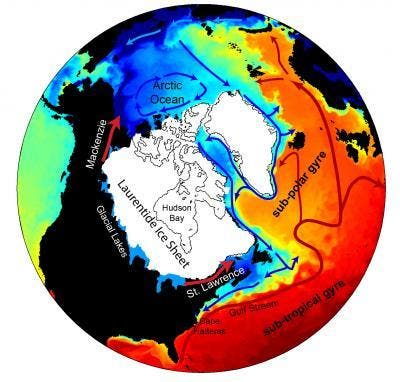Some 12,900 years ago, a massive flood of melted freshwater in the Arctic caused a 1,200-year-long chill nicknamed the “Big Freeze.” During this time much of the Northern Hemisphere was engulfed by centuries of cold, which caused the extinction of most great mammals, like mammoths, as well as the Clovis people. For decades, scientists have been debating from where and how did the freshwater flood flow. Now, a team of scientists may have finally reached a conclusion after they devised a computer model.
Technically known as the Younger Dryas, this specific period wasn’t a glacial period or what’s commonly referred to as an “ice age”, since it was a cold time in an otherwise warm span between ice ages. In other words, the Big Freeze wasn’t part of the Earth’s natural warm/cold cycle, it was triggered by an event. Previous theories held that a cosmic impact caused the Big Freeze, however recently scientist have reached to a common conclusion that a vast pulse of freshwater is to blame.

The source of this great flood was the massive glacial Lake Agassiz, located along the southern margin of the Laurentide Ice Sheet, which at its maximum 21,000 years ago was 6,500 to 9,800 feet (2,000 to 3,000 meters) thick and covered much of North America, from the Arctic Ocean south to Seattle and New York. Researchers believe the flood was caused by a sudden melting of an ice dam. The subsequent massive influx of freshwater diluted the circulation of saltwater in the North Atlantic, disrupting the ocean “conveyer belt” that transports heat to Europe and North America. The weakening of this circulation caused by the flood resulted in the dramatic cooling of North America and Europe.
Until recently, however, scientists weren’t sure whether the meltwater flowed northwest into the Arctic first, or east via the Gulf of St. Lawrence.
“This episode was the last time the Earth underwent a major cooling, so understanding exactly what caused it is very important for understanding how our modern-day climate might change in the future,” says Condron of UMass Amherst’s Climate System Research Center
Working with Peter Winsor at the University of Alaska, Condron used a high resolution, global, ocean-ice circulation model that is 10 to 20 times more powerful than previously attainable, to compare how different drainage outlets was delivered to the sinking regions in the North Atlantic. If Lake Aggasiz drained into the North Atlantic down the St. Lawrence River then the thermohaline circulation would have weakened by less than 15 percent. In contrast, when the meltwater first drains into the Arctic Ocean, narrow coastal boundary currents can efficiently deliver it to the deep water formation regions of the sub-polar north Atlantic, weakening the thermohaline circulation by more than 30 percent.
These findings hint that shifts in the flow of water in the Arctic could dramatically alter today’s climate.
“However, in our modern-day climate, there are no sources of freshwater as large as the glacial lakes or Laurentide Ice Sheet readily available to suddenly flood into the ocean,” Condron said. “As a result, we should be cautious using this study as an analog for what might trigger modern-day abrupt climate change.”
The researchers are able, however, to put their model to good use in other instances, though far less extreme, like studying the effects of the potential melting of large ice sheet over Greenland and changes in the hydrological cycle, such as increased river runoff of the Arctic in the near-future.
Findings were published in the journal Proceedings of the National Academy of Sciences.
Source: University of Massachusetts at Amherst






